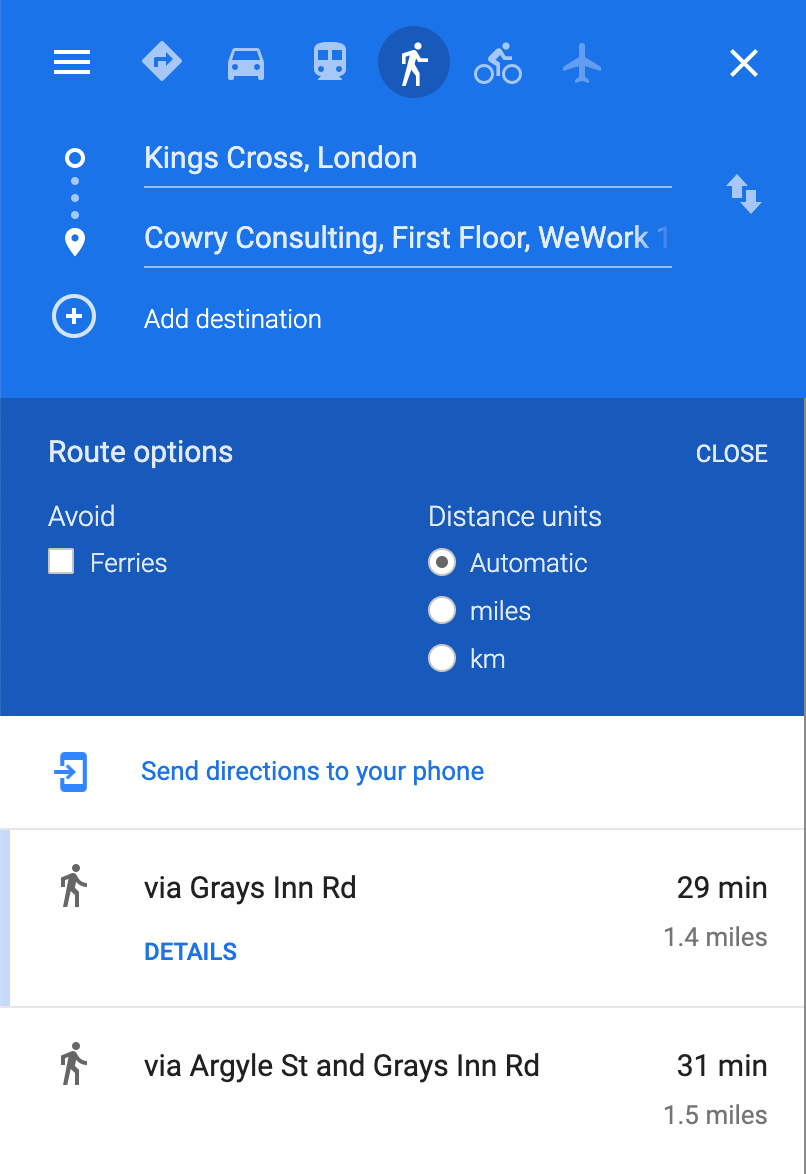Choice architecture describes how the layout, sequencing and range of choices available on a model affect subsequent decisions
Choice Architecture is Everywhere

Choice] architecture is inevitable, whether or not we see it. It is the equivalent of water. Weather is itself a form of choice architecture, because it influences how people decide; on snowy days, people are especially likely to purchase cars with four-wheel drive, which they will return to the market unusually quickly. Human beings cannot live without some kind of weather.
Nature nudges’ – Cass Sunstein
There is no such thing as neutral choice architecture. The relevant question is whether the choice architecture is intentional or not, and if it’s intentional, what is its intent?
The Unintended Impact of Google Maps
Choice architecture is always present, so the status quo may be sub-optimal and there may be unintended behavioural consequences.
Consider Google Maps, a ubiquitous part of our lives (at least when we used to travel). Its choice architecture has certainly had unintentional behavioural consequences on us through its emphasis to get us from A to B as quickly as possible. The metrics it shows are distance, commute time, and mode of commute. Have you noticed that there is no consideration for scenery? No consideration for those who may not want the fastest route? The implicit assumptions and functions of Google Maps have shaped our relationship and behaviour with travel. Those who preferred the scenic route before the rise of Google Maps are now more likely to value speed more, perhaps even prefer speed over scenery now.

This unintentional behavioural consequence could have been mitigated against by implementing intentional choice architecture, with an awareness of how the functions presented shape people’s options, and thus behaviour. Perhaps a ‘scenic route’ function? If anyone working in Google is reading this, get in touch.
What is the Best Choice Architecture?
Recognising that choice architecture is an inevitable reality of any product, service, and space, is the first step to creating better choice architecture. Take shopping in the supermarket as an example. Merely seeing something first makes it more likely that you’ll buy it (Dayan & Bar-Hillel, 2011). The layout of the supermarket is the choice architecture in this case; whether you first encounter fruit and veg; whether there are unhealthy snacks in the payment queues; what’s placed at the eye-gaze level.
The second step is redesigning for the best choice architecture. This is a question of intent. What is ‘best’? To earn the highest profit? To encourage healthy eating? To not encourage anything at all? The conversation of what is best isn’t easy, but intentional choice architecture, designed ethically, will most likely result in better outcomes than the status quo.
Designing ethically involves considering what’s in the customer’s interest, which is context dependent. More is not always better. Imagine it is decided that the ‘best’ setup exposes people to all items equally so that they can make decisions autonomously. This could be done by taking individuals through a long journey so that every single item at the supermarket is viewed, IKEA style. Not very efficient for your causal grocery shop but may work in the context of furniture shopping. People may consider more items this way, but the extra cognitive overload may have the unintended consequence of people not making any decision at all (Iyengar & Lepper, 2000).
Alternatively, consider that the ‘best’ setup is the one that maximises profit by showing items with the highest profit margin first. This could be effective in the short run but cause the supermarket reputational damage as savvy customers figure out the profit-maximising intent.
Countering this, what if the decided ‘best’ setup is the one that is free of manipulation. Is it more ethical to randomly allocate supermarket layouts so that no manipulation is at play? But what if it randomly allocates all the healthy foods out of arms-reach and eye gaze, which is less than desirable, especially in the rising health epidemic of today.
Reaching a conclusion on what is best is challenging, but intentional choice architecture designed ethically trumps unintentional designs any day.
Conclusion
It’s clear that choice architecture is omnipresent and impacts behaviour, whether we are aware of it or not. Therefore, businesses influence people’s behaviour through their choice architecture, even if they don’t think so. As a business, the power of choice architecture can be harnessed by considering the business’ intent and aligning the choice architecture with the goal. I do not doubt that Google Maps takes pride in getting users from A to B happily, but I wonder if they realised their product assumes that happy transport equals efficient transport? From the choice architecture of Google Maps, we now share this mindset with billions worldwide.
So, there you go. Choice architecture is inescapable. Rather than feeling restricted, I hope you feel empowered that we can design for better behaviours. Now if you will excuse me, my Google Maps has just notified me that I must leave in the next minute if I want to be on the next train.
Thoughts by Tina Soh
Discover more about Cowry now: https://www.cowryconsulting.com/
References:
Dayan, E., & Bar-Hillel, M. (2011). Nudge to nobesity II: Menu positions influence food orders. Judgment and Decision making, 6(4), 333–342.
Iyengar, S., & Lepper, M. (2000). When choice is demotivating: Can one desire too much of a good thing?.
Journal Of Personality And Social Psychology, 79(6), 995–1006. Sunstein, C. (2016). The ethics of influence (p. 35). New York, NY: Cambridge University Press